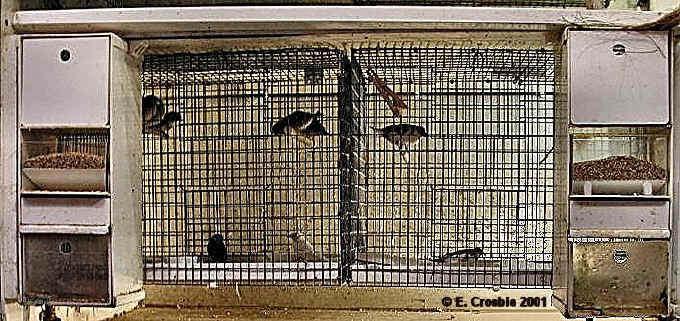Cages to foster Pin-tailed Parrot Finches - (46cm wide x
36cm high x 30cm deep), [18" x 14" x 12"]
All wire, suspended
Bottom trays - internal so can be raised during fledging
Seed capacity - large, so when not breeding, cages
self-sustaining for a week
Watering - automatic, 6 times a day
Lighting - normal fluorescent
Nest boxes - 13cm [5"] half-fronted white plastic cubes
Coconut fibre - only nesting material
Cock trios versus pairs - trios seem more reliable than duos,
especially at the critical stage of the first day or two after fledging
Used to resort to hand feeding newly fledged Pin-tailed youngsters for 3 or 4 days
until the Bengalese took over their duty. This appears to have been due to slightly
weak youngsters
With additional vitamins, probiotics, additives and protein boosted soft food, this
problem has mostly disappeared, with trios anyway
All-cock trios are more controllable than mixed trios. Mixed trios, or pairs, can
start laying when the Pin-tailed aren't at their prolific best
Fewer trios are required than pairs due to the timing issue with
pairs or mixed trios
Sitting Bengalese cocks are quite flexible. They have even taken over 2-day old
Pin-tailed chicks
This is when the Pin-tailed adults had secretly built a nest and hatched eggs unbeknown to me
Creating 'clucky' Bengalese - cock Bengalese can be relied
upon to go 'clucky' within 4 days. Place 1 china egg daily in nest box for
four or five consecutive mornings
Virgin Bengalese - it seems better that the Bengalese are
young and have not raised any Bengalese themselves. Bengalese as young as
3-months have proved enthusiastic and efficient foster parents
This is probably unnecessarily extreme, but I will not raise any Bengalese within
earshot of the foster Bengalese
Splitting nests - if the parent Pin-tailed are fully fit
and laying their 7 eggs, of which 6 will be fertile, I prefer to split the eggs between
two trios of foster Bengalese
This gives all youngsters the best possible chance
In the first few days after hatching the chicks can be moved and split
One foster trio is given the older youngsters which are most robust
and the other foster trio the smaller, less robust
This way the smaller Pin-tailed chicks are given good attention and food, so usually
have a good chance of surviving
Cages to foster Pin-tailed Parrot Finches - (46cm wide x
36cm high x 30cm deep), [18" x 14" x 12"]
All wire, suspended
Bottom trays - internal so can be raised during fledging
Seed capacity - large, so when not breeding, hold
week's seed
Watering - automatic, 6 times a day
Lighting - normal fluorescent
Nest boxes - 13cm [5"] half-fronted white plastic cubes
Coconut fibre - only nesting material
Cock trios versus pairs - trios seem more reliable than duos,
especially at the critical stage of the first day or two after fledging
Used to resort to hand feeding newly fledged Pin-tailed youngsters for 3 or 4 days
until the Bengalese took over their duty. This appears to have been due to slightly
weak youngsters
With additional vitamins, probiotics, additives and protein boosted soft food, this
problem has mostly disappeared, with trios anyway
All-cock trios are more controllable than mixed trios. Mixed trios, or pairs, can
start laying when the Pin-tailed aren't at their prolific best
Splitting nests - if the parent Pin-tailed have their usual 5 or 6
fertile eggs, I prefer to split the eggs between
two trios of fosters. This gives all youngsters the best possible chance
Even in first few days after hatching chicks can be moved and split
One foster trio is given the older youngsters which are most robust and the other foster trio
the smaller, less robust
This way smaller Pin-tailed chicks receive attention and food, so have a good chance of surviving









